Exploring the Impact of Music Preferences on Depressive Symptoms and Meaning in Life: A Network Analysis Approach
Abstract
1. Introduction
2. Materials and Methods
2.1. Participants and Data Collection
2.1.1. Recruitment Procedure
2.1.2. Inclusion and Exclusion Criteria
2.1.3. Data Collection Method
2.1.4. Response Rates and Sample Size
2.2. Scales
2.2.1. The Meaning in Life Questionnaire (MLQ)
2.2.2. The Patient Health Questionnaire (PHQ-9)
2.2.3. Music Preference Classification
2.3. Network Construction
2.4. Accuracy and Stability Assessment
3. Results
3.1. Descriptive Statistical Results of Major Demographic Characteristics
3.2. Exploratory Network Analysis of Meaning in Life and Depressive Symptoms
3.3. Centrality Analysis Results
3.4. Network Stability and Accuracy Test Results
3.5. The Comparative Network Analysis of Meaning in Life and Depressive Symptoms Between the Sad Music and Happy Music Groups
3.5.1. Analysis of Network Invariance Test Results
3.5.2. Global-Level Effect: Average Connection Strength
3.5.3. Node-Level Effect: Centrality of Key Nodes
3.5.4. Sensitivity Analysis
4. Discussion
4.1. Mechanisms Underlying Network Differences
4.2. Implications for Music Therapy Interventions
4.3. Limitations and Future Research Directions
5. Conclusions
Author Contributions
Funding
Institutional Review Board Statement
Informed Consent Statement
Data Availability Statement
Conflicts of Interest
Abbreviations
| SMG | Sad Music Group |
| HMG | Happy Music Group |
| MLQ | Meaning in Life Questionnaire |
| PHQ | Patient Health Questionnaire |
| GGM | Gaussian Graphical Model |
| EBIC | Extended Bayesian Information Criterion |
| CI | Confidence Interval |
| CS-coefficient | Correlation Stability Coefficient |
| BH | Benjamini–Hochberg |
Appendix A
| Life Label | Original Item | Dimension | Scoring Method |
|---|---|---|---|
| Life1 | I have been searching for the purpose or meaning of life. | MLQ-S (Search for Meaning) | Forward scoring (1 = Strongly Disagree to 7 = Strongly Agree) |
| Life2 | I often feel that life has no goal. (Reverse item) | MLQ-P (Presence of Meaning) | Reverse scoring (7 = Strongly Disagree to 1 = Strongly Agree) |
| Life3 | I actively explore the meaning of life. | MLQ-S | Forward scoring |
| Life4 | I know what the meaning of my life is. | MLQ-P | Forward scoring |
| Life5 | I will take the initiative to seek experiences that can make life meaningful. | MLQ-S | Forward scoring |
| Life6 | I continuously explore the goals of my life. (Deleted due to redundancy) | MLQ-S | Forward scoring |
| Life7 | I understand the meaning of my life. | MLQ-P | Forward scoring |
| Life8 | I know the source of the meaning of my life. | MLQ-P | Forward scoring |
| Life9 | I am satisfied with the purpose of my life. | MLQ-P | Forward scoring |
| Life10 | I pursue life goals that are important to me. | MLQ-S | Forward scoring |
| Variable | Sad Music Group (n = 320) M ± SD | Happy Music Group (n = 1361) M ± SD | t-Value | p-Value | Cohen’s d |
|---|---|---|---|---|---|
| Life1 (Life Meaning Presence Item1) | 4.8 ± 1.2 | 5.5 ± 1.1 | −8.76 | <0.001 | −0.63 |
| Life2 (Life Meaning Presence Item2) | 4.5 ± 1.3 | 5.2 ± 1.0 | −7.92 | <0.001 | −0.58 |
| Life3 (Life Meaning Presence Item3) | 4.6 ± 1.2 | 5.3 ± 1.1 | −8.24 | <0.001 | −0.61 |
| Life4 (Life Meaning Presence Item4) | 4.7 ± 1.3 | 5.4 ± 1.0 | −8.01 | <0.001 | −0.59 |
| Life5 (Life Meaning Presence Item5) | 4.9 ± 1.2 | 5.6 ± 1.0 | −8.53 | <0.001 | −0.62 |
| Life6 (Life Meaning Search Item1) | 5.3 ± 0.9 | 4.8 ± 0.8 | 7.65 | <0.001 | 0.57 |
| Life7 (Life Meaning Search Item2) | 5.1 ± 0.8 | 5.6 ± 0.7 | −8.32 | <0.001 | −0.60 |
| Life8 (Life Meaning Search Item3) | 5.2 ± 0.9 | 5.7 ± 0.8 | −7.89 | <0.001 | −0.57 |
| Life9 (Life Meaning Search Item4) | 5.0 ± 0.9 | 5.5 ± 0.7 | −8.11 | <0.001 | −0.59 |
| Life10 (Life Meaning Search Item5) | 5.2 ± 0.8 | 5.6 ± 0.7 | −7.76 | <0.001 | −0.56 |
| PHQ1 (Anhedonia) | 1.8 ± 0.9 | 1.2 ± 0.7 | 10.32 | <0.001 | 0.74 |
| PHQ2 (Depressed Mood) | 1.9 ± 0.9 | 1.3 ± 0.7 | 10.89 | <0.001 | 0.78 |
| PHQ3 (Sleep Disturbance) | 1.7 ± 0.8 | 1.1 ± 0.6 | 11.23 | <0.001 | 0.81 |
| PHQ4 (Depressive Fatigue) | 2.1 ± 1.0 | 1.3 ± 0.8 | 12.05 | <0.001 | 0.87 |
| PHQ5 (Appetite Disturbance) | 1.6 ± 0.8 | 1.0 ± 0.6 | 10.56 | <0.001 | 0.76 |
| PHQ6 (Guilt) | 1.5 ± 0.8 | 0.9 ± 0.6 | 10.11 | <0.001 | 0.72 |
| PHQ7 (Concentration Difficulty) | 1.7 ± 0.8 | 1.1 ± 0.7 | 10.67 | <0.001 | 0.77 |
| PHQ8 (Psychomotor Agitation/Retardation) | 1.4 ± 0.7 | 0.8 ± 0.5 | 11.34 | <0.001 | 0.82 |
| PHQ9 (Suicidal Ideation) | 0.8 ± 0.6 | 0.3 ± 0.4 | 12.78 | <0.001 | 0.93 |


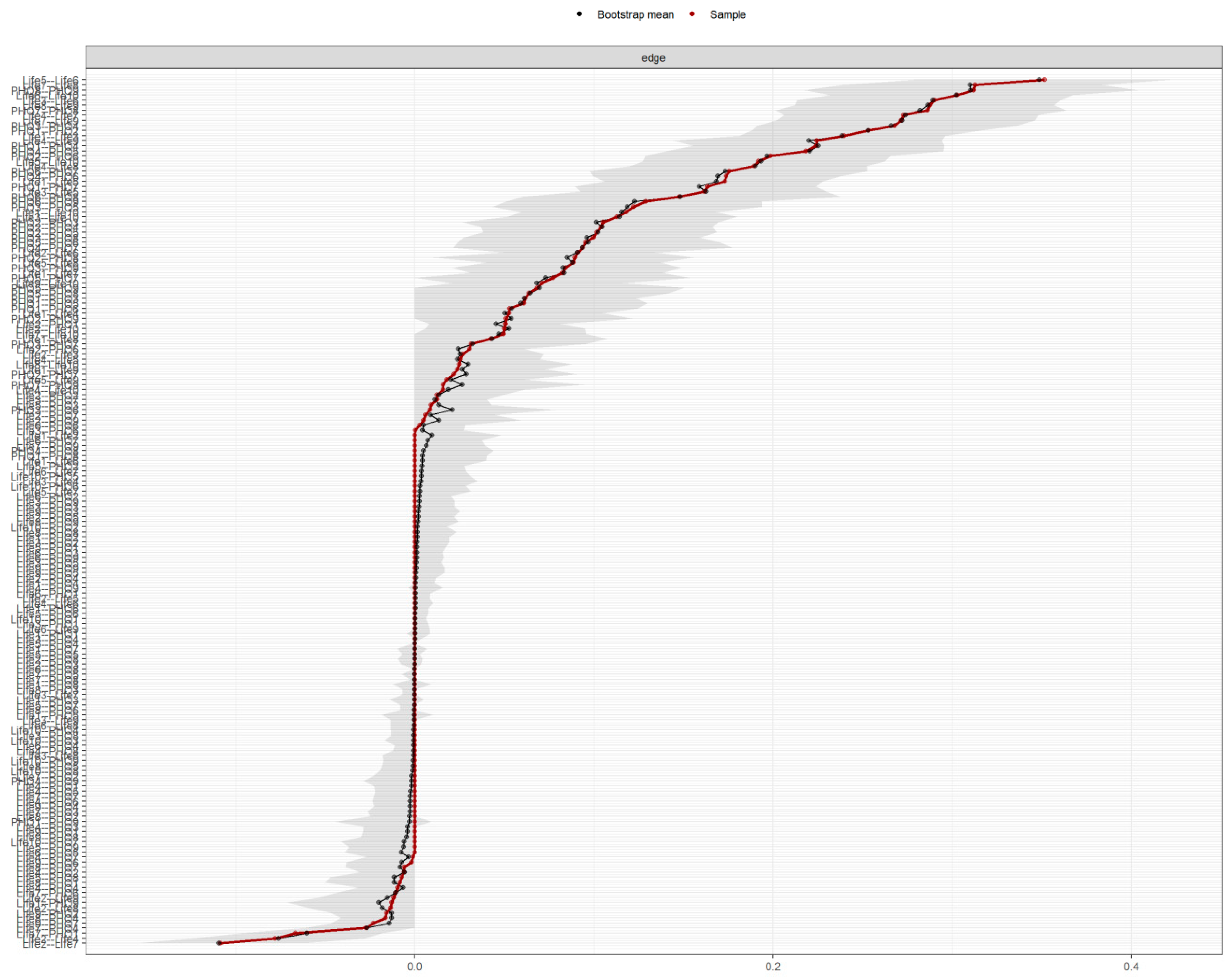
References
- Arens, E. A., & Stangier, U. (2020). Sad as a matter of evidence: The desire for self-verification motivates the pursuit of sadness in clinical depression. Frontiers in Psychology, 11, 238. [Google Scholar] [CrossRef]
- Bamonti, P., Lombardi, S., Duberstein, P. R., King, D. A., & Van Orden, K. A. (2016). Spirituality attenuates the association between depression symptom severity and meaning in life. Aging & Mental Health, 20(5), 494–499. [Google Scholar] [CrossRef]
- Blasco-Magraner, J. S., Bernabé-Valero, G., Marín-Liébana, P., & Botella-Nicolás, A. M. (2023). Changing positive and negative affects through music experiences: A study with university students. BMC Psychology, 11(1), 76. [Google Scholar] [CrossRef]
- Błażek, M., Kaźmierczak, M., & Besta, T. (2015). Sense of purpose in life and escape from self as the predictors of quality of life in clinical samples. Journal of Religion and Health, 54(2), 517–523. [Google Scholar] [CrossRef]
- Chao, M., Chen, X., Liu, T., Yang, H., & Hall, B. J. (2020). Psychological distress and state boredom during the COVID-19 outbreak in China: The role of meaning in life and media use. European Journal of Psychotraumatology, 11(1), 1769379. [Google Scholar] [CrossRef] [PubMed]
- Cohen, J. (1988). Statistical power analysis for the behavioral sciences (2nd ed.). Lawrence Erlbaum Associates, Publishers. [Google Scholar]
- Dezutter, J., Luyckx, K., & Wachholtz, A. (2015). Meaning in life in chronic pain patients over time: Associations with pain experience and psychological well-being. Journal of Behavioral Medicine, 38(2), 384–396. [Google Scholar] [CrossRef]
- Dulaney, E. S., Graupmann, V., Grant, K. E., Adam, E. K., & Chen, E. (2018). Taking on the stress-depression link: Meaning as a resource in adolescence. Journal of Adolescence, 65, 39–49. [Google Scholar] [CrossRef]
- Eerola, T., & Peltola, H. R. (2016). Memorable experiences with sad music-reasons, reactions and mechanisms of three types of experiences. PLoS ONE, 11(6), e0157444. [Google Scholar] [CrossRef]
- Eerola, T., Vuoskoski, J. K., & Kautiainen, H. (2016). Being moved by unfamiliar sad music is associated with high empathy. Frontiers in Psychology, 7, 1176. [Google Scholar] [CrossRef]
- Epskamp, S., Borsboom, D., & Fried, E. I. (2018). Estimating psychological networks and their accuracy: A tutorial paper. Behavior Research Methods, 50(1), 195–212. [Google Scholar] [CrossRef] [PubMed]
- Epskamp, S., Cramer, A. O. J., Waldorp, L. J., Schmittmann, V. D., & Borsboom, D. (2012). qgraph: Network visualizations of relationships in psychometric data. Journal of Statistical Software, 48, 1–18. [Google Scholar] [CrossRef]
- Fried, E. I., Epskamp, S., Nesse, R. M., Tuerlinckx, F., & Borsboom, D. (2016). What are “good” depression symptoms? Comparing the centrality of DSM and non-DSM symptoms of depression in a network analysis. Journal of Affective Disorders, 189, 314–320. [Google Scholar] [CrossRef]
- Garrido, S., Eerola, T., & McFerran, K. (2017). Group rumination: Social interactions around music in people with depression. Frontiers in Psychology, 8, 490. [Google Scholar] [CrossRef]
- Kroenke, K., Spitzer, R. L., & Williams, J. B. (2001). The PHQ-9: Validity of a brief depression severity measure. Journal of General Internal Medicine, 16(9), 606–613. [Google Scholar] [CrossRef]
- Palmiero, M., Piccardi, L., Giancola, M., Nori, R., & Guariglia, P. (2023). The effect of sadness on visual artistic creativity in non-artists. Brain Sciences, 13(1), 149. [Google Scholar] [CrossRef] [PubMed]
- Putkinen, V., Makkonen, T., & Eerola, T. (2017). Music-induced positive mood broadens the scope of auditory attention. Social Cognitive and Affective Neuroscience, 12(7), 1159–1168. [Google Scholar] [CrossRef]
- Raji Lahiji, M., Sajadian, A., Haghighat, S., Zarrati, M., Dareini, H., Raji Lahiji, M., & Razmpoosh, E. (2022). Effectiveness of logotherapy and nutrition counseling on psychological status, quality of life, and dietary intake among breast cancer survivors with depressive disorder: A randomized clinical trial. Supportive Care in Cancer, 30(10), 7997–8009. [Google Scholar] [CrossRef] [PubMed]
- Saarikallio, S., Gold, C., & McFerran, K. (2015). Development and validation of the healthy-unhealthy music scale. Child and Adolescent Mental Health, 20(4), 210–217. [Google Scholar] [CrossRef]
- Steger, M. F., Frazier, P., Oishi, S., & Kaler, M. (2006). The meaning in life questionnaire: Assessing the presence of and search for meaning in life. Journal of Counseling Psychology, 53(1), 80. [Google Scholar] [CrossRef]
- Szcześniak, M., Świątek, A. H., Cieślak, M., & Świdurska, D. (2020). Disease acceptance and eudemonic well-being among adults with physical disabilities: The mediator effect of meaning in life. Frontiers in Psychology, 11, 525560. [Google Scholar] [CrossRef]
- van Borkulo, C. D., Borsboom, D., Epskamp, S., Blanken, T. F., Boschloo, L., Schoevers, R. A., & Waldorp, L. J. (2014). A new method for constructing networks from binary data. Scientific Reports, 4, 5918. [Google Scholar] [CrossRef] [PubMed]
- Zhang, J., Peng, J., Gao, P., Huang, H., Cao, Y., Zheng, L., & Miao, D. (2019). Relationship between meaning in life and death anxiety in the elderly: Self-esteem as a mediator. BMC Geriatrics, 19(1), 308. [Google Scholar] [CrossRef] [PubMed]
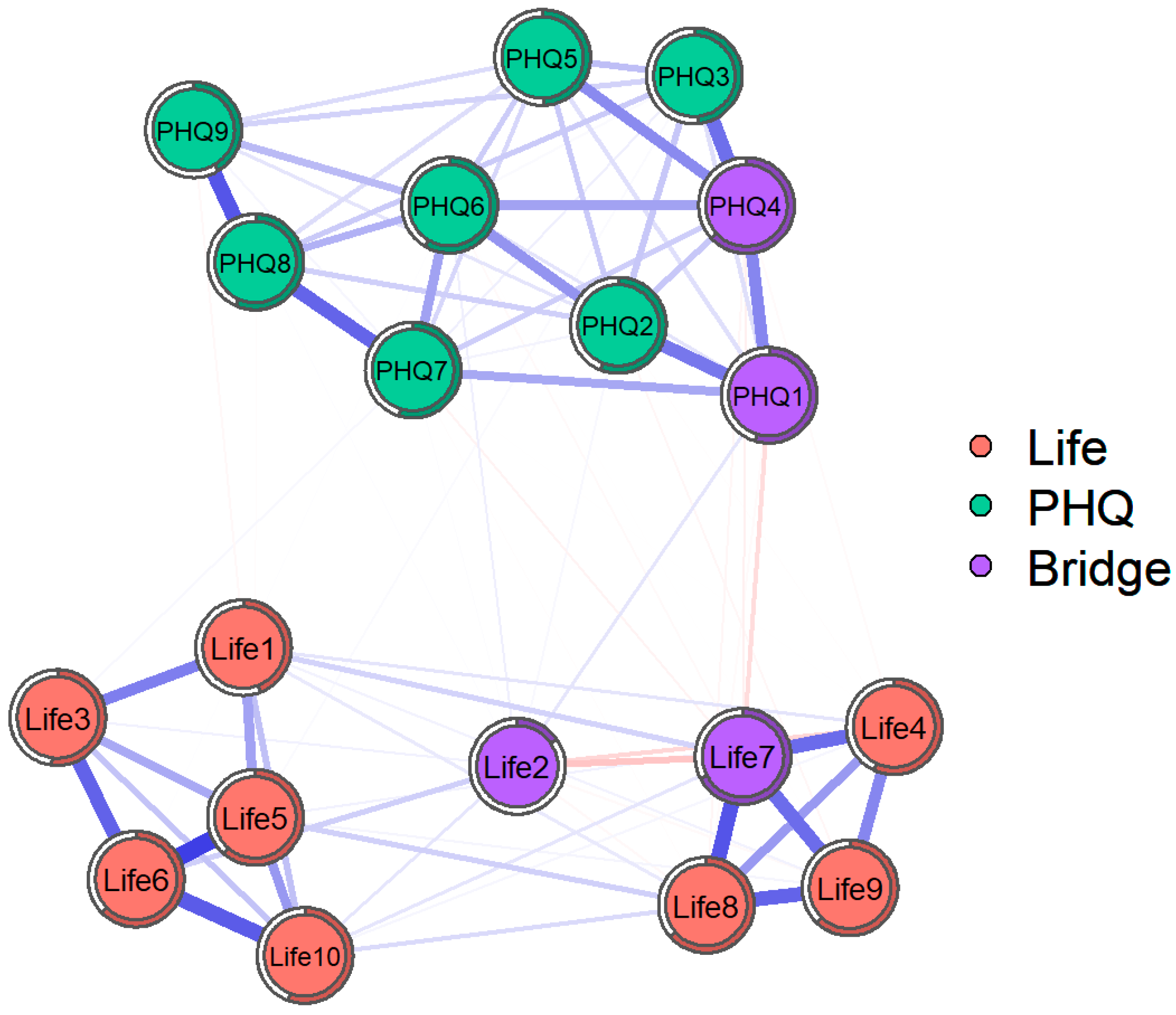
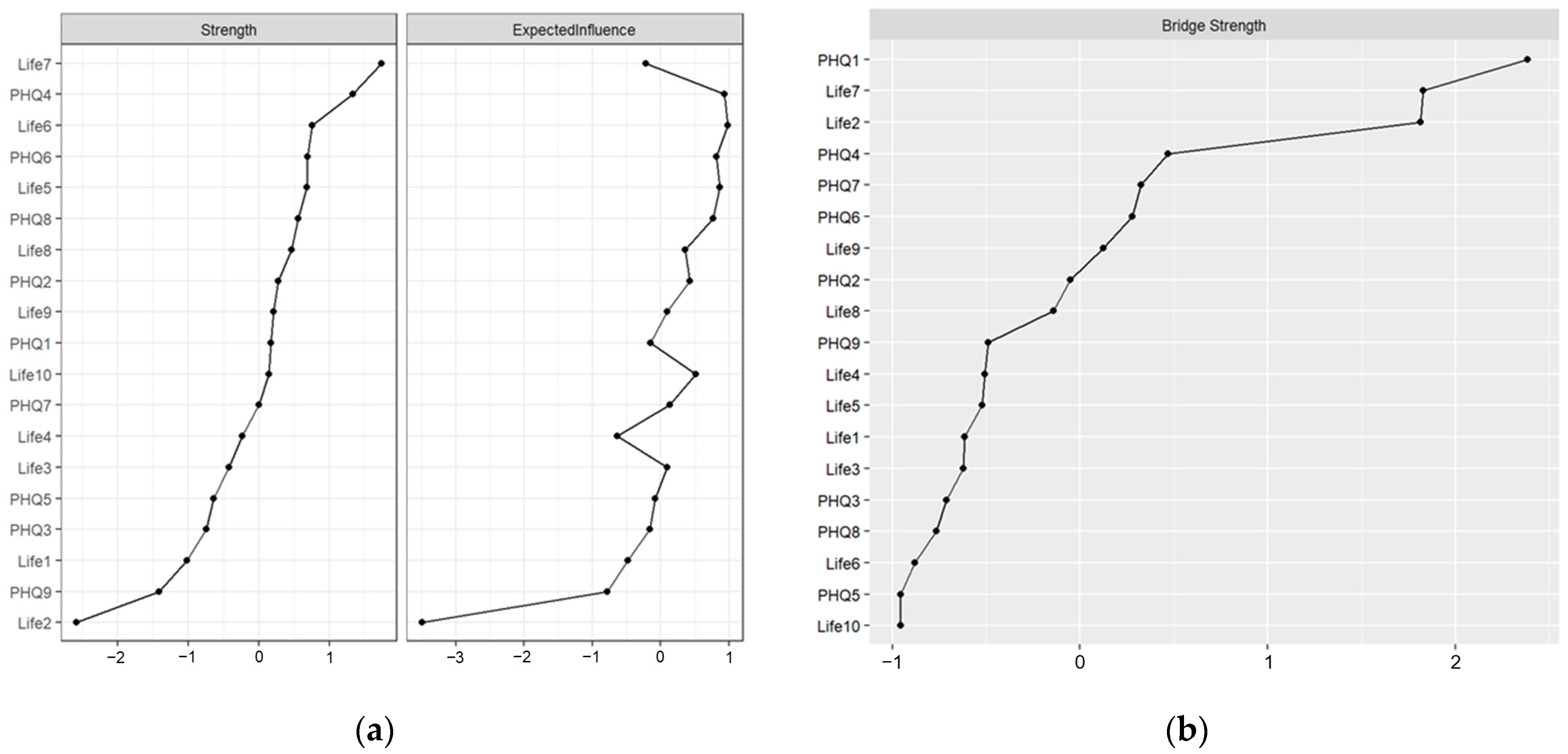
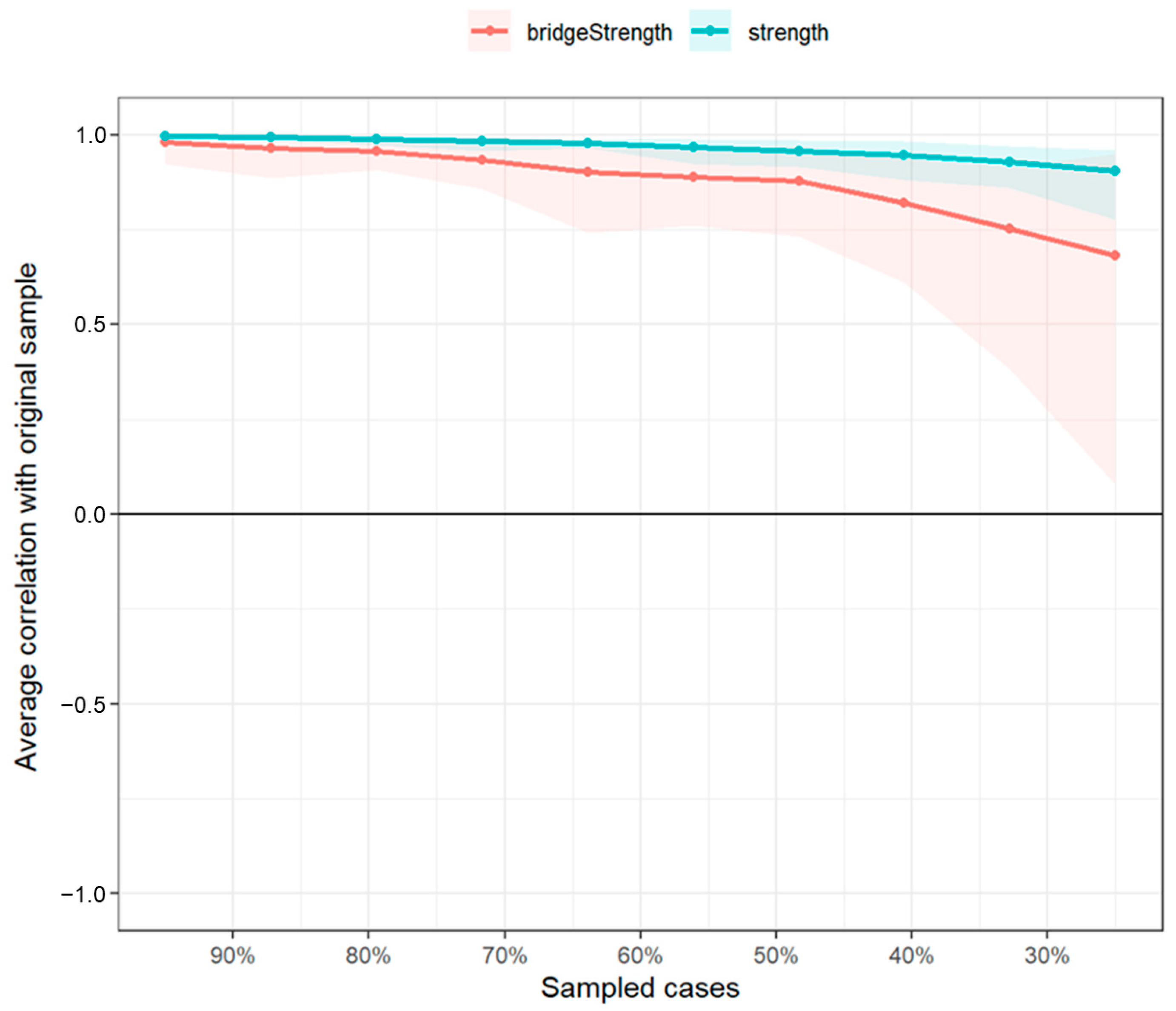
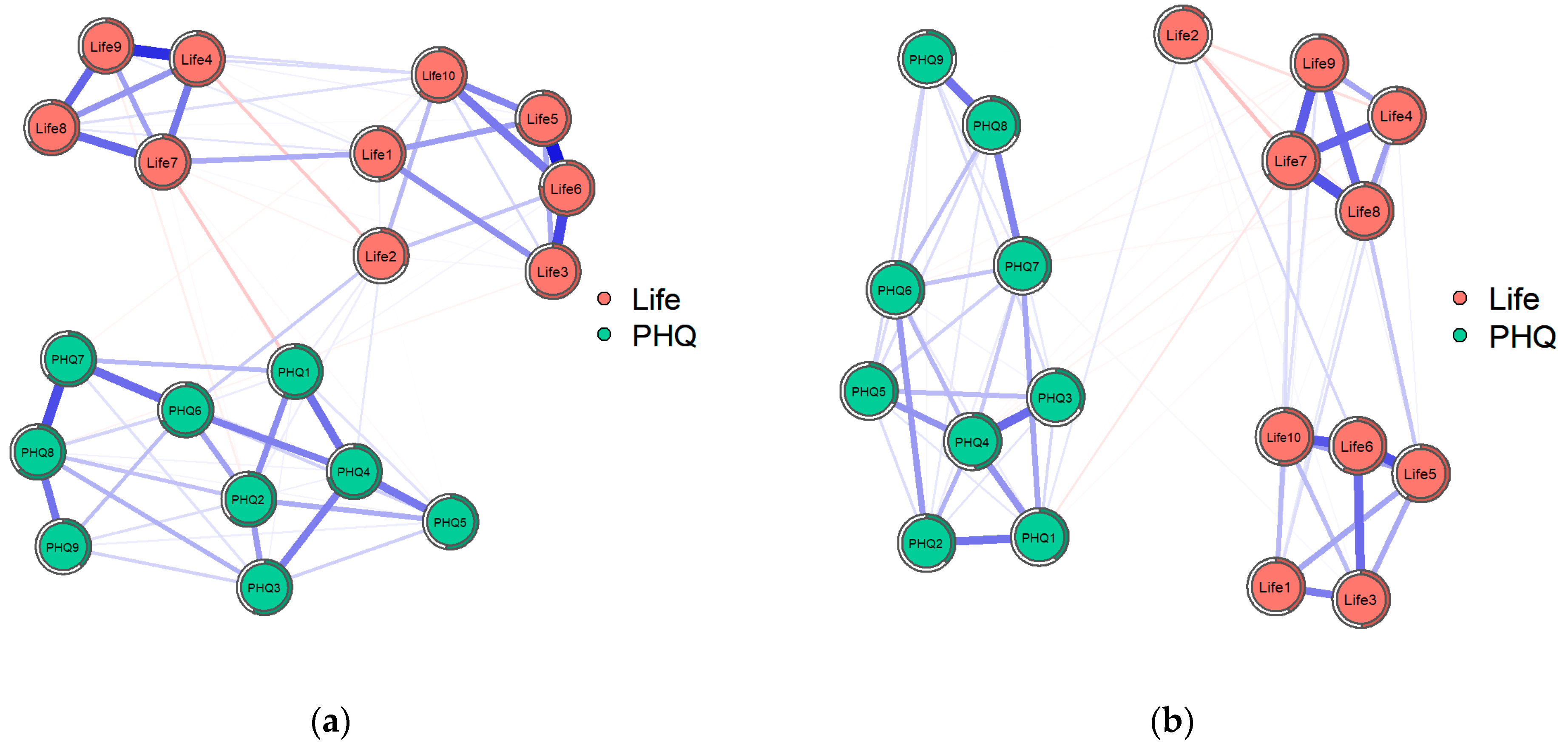
| Node | Strength | Expected Influence | Node | Strength | Expected Influence |
|---|---|---|---|---|---|
| Life1 | −1.013 | −0.478 | PHQ1 | 0.171 | −0.148 |
| Life2 | −2.591 | −3.493 | PHQ2 | 0.279 | 0.423 |
| Life3 | −0.419 | 0.090 | PHQ3 | −0.745 | −0.157 |
| Life4 | −0.229 | −0.633 | PHQ4 | 1.339 | 0.936 |
| Life5 | 0.685 | 0.863 | PHQ5 | −0.637 | −0.075 |
| Life6 | 0.755 | 0.982 | PHQ6 | 0.693 | 0.819 |
| Life7 | 1.746 | −0.216 | PHQ7 | 0.002 | 0.135 |
| Life8 | 0.464 | 0.358 | PHQ8 | 0.559 | 0.767 |
| Life9 | 0.214 | 0.093 | PHQ9 | −1.418 | −0.785 |
| Life10 | 0.144 | 0.518 |
| Measure | CS-Coefficient * |
|---|---|
| Bridge Strength | 0.517 |
| Edge | 0.75 |
| Strength | 0.75 |
| Test Type | Parameter | Value (SMG) | Value (HMG) | T | p | Cohen’s d | Effect Size Category |
|---|---|---|---|---|---|---|---|
| Network Invariance | Test Statistic M | - | - | 0.212 | 0.465 | ||
| Global Strength Invariance | Global Strength | 8.816 ± 1.02 | 7.981 ± 0.95 | - | - | 0.32 | Small |
| Test Statistic S | - | - | 0.836 | 0.019 |
| Key Node | Music Preference Group | Strength Centrality (M ± SD) | p-Value | Cohen’s d | Effect Size Category |
|---|---|---|---|---|---|
| Life7 | SMG | 4.41 ± 0.21 | 0.0001 | −0.52 | Medium |
| HMG | 5.08 ± 0.18 | ||||
| PHQ4 | SMG | 0.97 ± 0.19 | 0.0001 | 1.07 | Large |
| HMG | 0.29 ± 0.16 | ||||
| Life6 | SMG | 4.72 ± 0.15 | 0.0009 | −0.22 | Small |
| HMG | 5.03 ± 0.14 |
Disclaimer/Publisher’s Note: The statements, opinions and data contained in all publications are solely those of the individual author(s) and contributor(s) and not of MDPI and/or the editor(s). MDPI and/or the editor(s) disclaim responsibility for any injury to people or property resulting from any ideas, methods, instructions or products referred to in the content. |
© 2025 by the authors. Licensee MDPI, Basel, Switzerland. This article is an open access article distributed under the terms and conditions of the Creative Commons Attribution (CC BY) license (https://creativecommons.org/licenses/by/4.0/).
Share and Cite
Yue, Q.; Lin, Y.; Yang, B.; Zheng, M. Exploring the Impact of Music Preferences on Depressive Symptoms and Meaning in Life: A Network Analysis Approach. Behav. Sci. 2025, 15, 1311. https://doi.org/10.3390/bs15101311
Yue Q, Lin Y, Yang B, Zheng M. Exploring the Impact of Music Preferences on Depressive Symptoms and Meaning in Life: A Network Analysis Approach. Behavioral Sciences. 2025; 15(10):1311. https://doi.org/10.3390/bs15101311
Chicago/Turabian StyleYue, Qizong, Yuqi Lin, Bo Yang, and Maoping Zheng. 2025. "Exploring the Impact of Music Preferences on Depressive Symptoms and Meaning in Life: A Network Analysis Approach" Behavioral Sciences 15, no. 10: 1311. https://doi.org/10.3390/bs15101311
APA StyleYue, Q., Lin, Y., Yang, B., & Zheng, M. (2025). Exploring the Impact of Music Preferences on Depressive Symptoms and Meaning in Life: A Network Analysis Approach. Behavioral Sciences, 15(10), 1311. https://doi.org/10.3390/bs15101311





